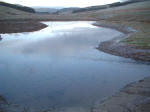 Glenholm Wildlife Project
Glenholm Wildlife Project
 Glenholm Wildlife Project
Glenholm Wildlife Project
 For a close
up view of wildlife in Glenholm, come and visit our hide overlooking the
Glenholm pond. You’ll certainly see a range of birds (oystercatchers and
curlew in the spring and early summer; herons, pheasants, mallards and a variety
of smaller birds throughout the year) and if lucky might even
see our local otters. For a more comfortable view pop into the Glenholm
Centre where you can view (and control) pictures transmitted from the pond.
For a close
up view of wildlife in Glenholm, come and visit our hide overlooking the
Glenholm pond. You’ll certainly see a range of birds (oystercatchers and
curlew in the spring and early summer; herons, pheasants, mallards and a variety
of smaller birds throughout the year) and if lucky might even
see our local otters. For a more comfortable view pop into the Glenholm
Centre where you can view (and control) pictures transmitted from the pond.
 The
Glenholm pond was dug at the end of 2004 about 1 kilometre from the Glenholm
Centre in a particularly marshy area of the Holms Water valley which was
occasionally grazed by sheep and cattle. It is an ideal wildlife site.
The
Glenholm pond was dug at the end of 2004 about 1 kilometre from the Glenholm
Centre in a particularly marshy area of the Holms Water valley which was
occasionally grazed by sheep and cattle. It is an ideal wildlife site.
The location and shape of the pond and a number of scrapes in the wetland immediately below the pond (see picture right) were decided upon after discussions with both the RSPB and FWAG (the Farm Wildlife Advisory Group).
The development plan for the pond currently includes the establishment of an island (possibly floating) as a base for duck and/or wader nesting sites, and the digging of additional scrapes in the area immediately adjacent to the hide.
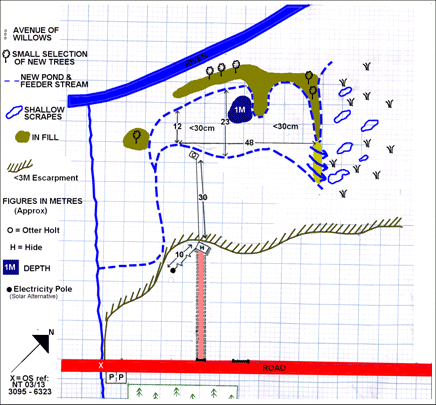
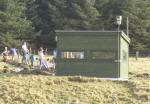 The hide, located at
the top of an escarpment overlooking the pond, was installed in January 2005.
This is
accessed
via a path within an avenue of hedging which eventually will provide food and
protection for birds, and privacy for wildlife around the pond.
The hide, located at
the top of an escarpment overlooking the pond, was installed in January 2005.
This is
accessed
via a path within an avenue of hedging which eventually will provide food and
protection for birds, and privacy for wildlife around the pond.
The hedging is primarily hawthorn but includes some blackthorn, rose and other native hedge species. It was planted by the Tweeddale Wildlife Watch Group in the Spring of 2005. Plans are in place to extend this hedge along the roadside to ensure that any wildlife in the pond area is not disturbed as people approach the hide.
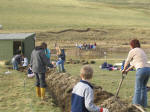
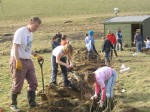
The whole wetland area is fenced and, apart from the hide, is out of bounds to people and dogs. The hide is wheelchair accessible.
Although rarely seen, otters are known to use the Holms Water. They have been seen at Glenhighton and Glencotho (both upstream of the pond) and at Rachan further downstream. Otter spraints (droppings) have also been found under the bridge next to the Cardon Farm steading and in October 2005 after a period of heavy rain an otter was seen in the stream that passes under the road next to the Millennium Wood..
Having built an artificial holt on the banks of the pond plan, we hope to encourage the otters to take up residence in the area. The pipe and chamber holt was built next to the pond by the Tweeddale Wildlife Watch Group using a plan which is available as one of the Fact Sheets put together by the Dorset Otter Group of the Dorset Wildlife Trust.
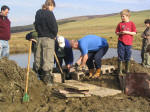

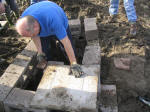
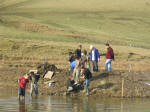
In the Spring of 2005 around 90 trees and shrubs were planted around the pond by pupils of Broughton Primary School. As these develop they will give cover and food to the wildlife. Only native trees and shrubs of particular value to wildlife were planted. The species and number of each species were chosen by the pupils under the expert guidance of the Borders Forest Trust.
Behind the hide overlooking the pond is a shelter belt of conifers. There are plans to put nesting boxes into these woods, again to attract a wider range of birdlife.
In addition to the hide, a camera with zoom facilities and remote control has been mounted above the hide and beams the pictures back to the Glenholm Centre. This allows visitors to the Centre to be able to control the camera without visiting the hide.
If the artificial holt, in time, is used, a second camera will be put into the holt again to provide pictures to be viewed back at the Centre. Two small diameter tubes have been built into the sides of the otter holt for this purpose.
Within the Centre the pictures may be viewed in the lounge and tea room, in the Centre's training room, and also are distributed to all guest rooms so that residential visitors can access the wildlife channel from the comfort of their bedroom. All images are recorded and ‘highlights’ packages prepared from these for people to view when the pond and holt area are quiet and as an additional channel within the guest rooms.
Equipment to provide these facilities was supplied by the Forestry Commission's Mechanical Engineering Services division.

 © Glenholm Wildlife Project
© Glenholm Wildlife Project